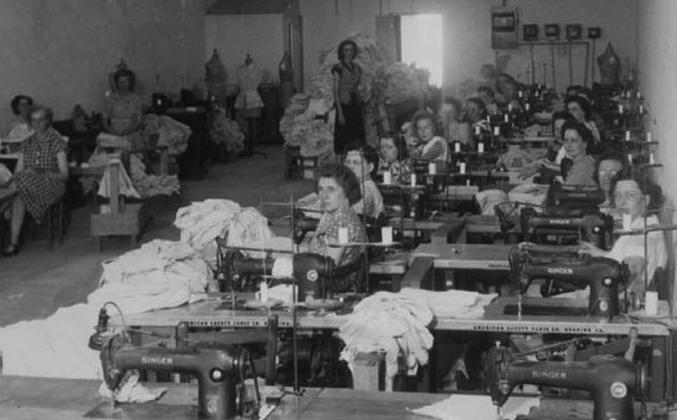In my reading of the newspapers, I have seen several articles about Mayor Hoffman wanting to create jobs in Dublin. In The Dublin Progress for December 15, 1950 one of his dreams came true. A newly built structure 41 by 90 feet was to be to be used as a new factory. The Dublin Manufacturing Company would be filling government contracts for clothing. What was called the sewing factory by local people was needed for the jobs it created.
In February of 1961, the factory was working under the Gillsam name. The factory had just finished a contract in excess of 1 million dollars. Their newest contract was for the U.S. Navy making raincoats. The coats were made of water repellent blue oxford cloth.
For this contract, the main garment sewing took place in the large factory building. L. T. Cooper in a recent interview, went on to say that the factory management was very concerned that each part of a garment would match. The bolts of material could very in color from one bolt to another so each garment would have to be made from the same bolt of cloth.
The bolts of material would be rolled out on long tables and the pieces would be cut from them. The bolts must have been 20 yards long. Then, they would sew the oxford cloth pieces together. The sewn garments were then sent to the next person in the assembly line who would put a water sealant caulk along the seams so that they were water tight.
The sewn garments were then sent to the two story building across the street from the Dublin Bottling Works. There, the seams were examined by women holding them up to the skylight. L. T. Cooper who worked there, said that the bright skylight shown through the seams so that they could make sure there were no leaks. A large contract like this allowed high school kids to have extra employment. They would work at night and then clean up after the days work. The working students would next put powder on the garment and pack them up to be sent out. Sometimes the kids would get too liberal with the powder and the women working at the skylight would finish up with power all over them. Rex Carter who was the manager there was very tolerant of the kids.
Charles and Sarah Harris who managed the operation at that time said this contract was one of the larger ones for the company. Cooper says that they were great people to work for. This factory continued to serve the community for a number of years. It was a real benefit to the town.


